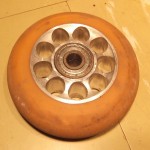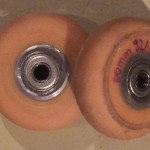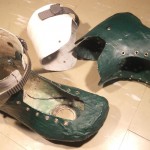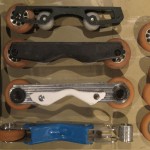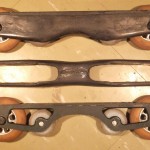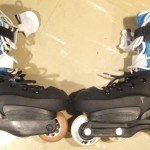1. Introduce yourself!
My name is Maciej Malicki. I am 28 years old. I live in Warsaw. I have a higher technical education. I’m interested in developing the study of materials and machine parts. Blah blah blah. I have been skating for 14 years.
2. Where did the idea for your own frames come from?
The idea came from the needs. I wanted to blade faster without losing control when performing tricks. The frames available on the market simply did not meet my expectations.
3. How the first frame prototypes performed?
The first prototype frames came out pretty weird, but it was the effect of minimizing the cost of implementation of the setup.
The results were positive enough to make another prototype, this time with commonly used solutions. The outcome was a prototype setup, which was then checked by Piotr Combrzyński at the skatepark in Piaseczno. 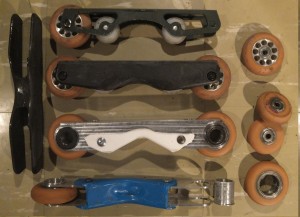 According to Piotrek the frames are actually cool. You get the speed that is somewhere between powerblading and aggressive while tricks locked well. Piotr pointed out few important things – the size of the groove need to be adjusted, and the side walls caught the ground with sharp turns. Some cracks appeared on the side walls, but it was expected – the first prototypes were just cut from cutting board plastic. They were used only to check how the frames “feel”.
According to Piotrek the frames are actually cool. You get the speed that is somewhere between powerblading and aggressive while tricks locked well. Piotr pointed out few important things – the size of the groove need to be adjusted, and the side walls caught the ground with sharp turns. Some cracks appeared on the side walls, but it was expected – the first prototypes were just cut from cutting board plastic. They were used only to check how the frames “feel”.
4. Early pics of your designs included some wheels – could you tell us more?
Their size is 80mm. Thee were made with polyurethane and a core of high-strength aluminum alloy. Those wheels should withstand a five-meter gaps by people weighing 220 pounds, yet they are quite slippery on the concrete, smooth ground. This is mainly the result of their hardness. They eventually had to have a 87-88A rating, unfortunately, the company that made them for me does not offer the possibility of selecting the hardness of polyurethane in the production unit. To sum it up – they are super durable but little to hard.
5. Can we expect further projects in the future (skates)?
I think so. In the near future, however, it will be important for me to refine and improve the hardware that I already made. In early January, I’m going to finish a new model of side walls for my frames. I followed the observations and conclusions from previous tests. I am currently at the stage of selecting the materials to make them. Recent attempts come out promising. Side-walls are not cracking and slides so well. In long distance, I would like to finish the model of skates that I started once – made entirely of chemically hardened plastics!



